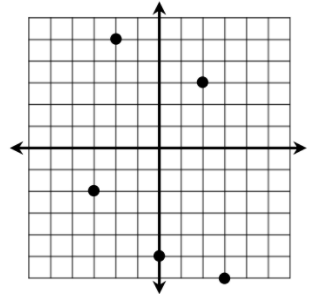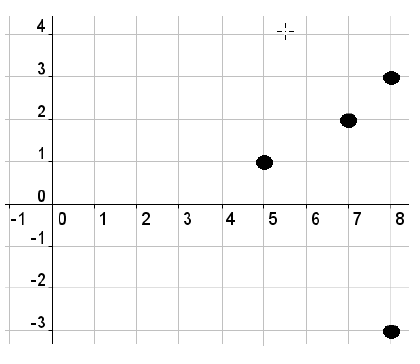This word is used to describe the set of all inputs (x values) for a function.
Domain.
No, not a function. It does not pass the vertical line test.
f(-3) if f(x) = 2x +1
f(-3) = -5
List the DOMAIN:
{(-2, 4), (3, 2), (2, 10)}
{-2, 3, 2}
f(x)=2x+3
g(x)=x-1
Find (f+g)(3)
11
This word is used to describe the set of all outputs (y-values) of a function.
Range.
Yes, it passes the vertical line test.
g(x) = -8x + 2
Find g(4)
g(4) = -30
List the RANGE in

{-6, -5, -2, 3, 5}
g(x)=x-4
find (f-g)(-2)
-12
This word describes a relation that pairs each x value with only one y value.
Function
Does the following table represent a function?
x y
1 2
2 5
6 2
2 9
5 1
No, because the input (x) of 2 has two different outputs (y).
Let f(x) = x2 + x + 1; find f(-5).
f(-5) = 21?
{ (-5,7) , (0,0) , (2, -8) , (5, -20) }
List the domain.
{-5, 0, 2, 5}
f(x)=x^2-3
g(x)=x-2
Find (fg)(5)
66
What visual test can be used to determine if a graph is a function?
Vertical Line Test.
Does the following table represent a function?
x y
-3 1
-1 4
0 6
2 4
5 1
Yes, there are no repeated x-values
g(x) = -3x2
Find g(-5)
g(-5) = -75
{ (-5,7) , (0,0) , (2, -8) , (5, -20) }
List the range.
{-20, -8, 0 , 7}
f(x)=x^2-7
g(x)=2x
Find (f/g)(-2)
3/4
Give three possible ways a function can be represented.
Graph, Mapping Diagram, Table, Ordered Pairs
Is this a function and why?

No, because x's repeat at 8.
Find the f(x) if f(10)
f(x) = 2/5x + 4
f(10) = 8
Find the DOMAIN:
-5<=x<=8 or (-5,8]
f(x)=4x-5
g(x)=8x+2
Find (g-f)(x)
4x+7